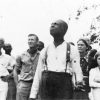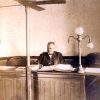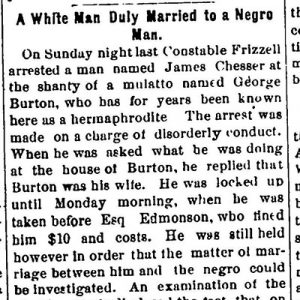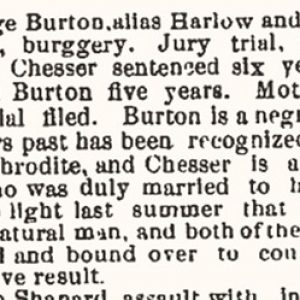calsfoundation@cals.org
Chesser and Holly Marriage Case of 1888
On May 10, 1888, James Chesser purchased a marriage license for himself and Georgeanna Holly from the Sebastian County Clerk’s office in Fort Smith (Sebastian County). Later that day, they were married in Holly’s “shanty” house by Presbyterian minister Graham C. Campbell. James Chesser was a twenty-three-year-old white man who worked as a day laborer. Georgeanna Holly was a Black or mixed-race person in their mid-twenties. Penitentiary records gave Holly’s profession as “pants washed and ironed,” which suggests laundry or textile work.
In early July 1888, James Chesser was arrested at home for disorderly conduct by constable James G. Frizzell. “Disorderly conduct” was a broad crime in Fort Smith and included many different acts of public disruption or nuisance; it is unclear what justification was given for Chesser’s arrest. Chesser went before police court judge Samuel Edmondson II. The standard punishment for disorderly conduct was a fine of $10. Newspaper reports differ, but at some point during arrest or the police court trial, Chesser stated that Holly was his wife. Holly’s gender raised questions with the officers, and, with this admission, court officials went to the county court and obtained the marriage certificate to confirm the marriage. In the meantime, Holly was detained in the county jail. A doctor was ordered by Judge Edmondson to inspect Holly physically. Upon this inspection, Holly was declared by the doctor to be a man, namely a person known as George Burton. All later court and penitentiary records present Holly’s name as George Harlow.
Using the marriage certificate as evidence, both individuals were charged with “buggery” and held for a juried circuit court trial. Chesser and Holly were defended by attorneys Thomas Marcum and W. S. Wolfinberger. Both defendants entered a not guilty plea. The jury found both Chesser and Holly guilty of buggery on October 26, 1888. Holly was sentenced to the minimum for buggery, five years in the Arkansas state penitentiary, while Chesser was sentenced to six years.
This is one of the earliest convicted cases of buggery or sodomy in the state of Arkansas where individuals were sentenced to the penitentiary, with only four previous ones documented in records beginning in 1881. It is unknown why Chesser was sentenced to six years, but in the penitentiary and newspaper records, a sentence over the five-year minimum for sodomy and buggery was extremely rare and only given when individuals committed buggery or sodomy along with other crimes. Based on rapidly changing racial laws and norms in Arkansas during late Reconstruction, moving into the Jim Crow era, the extra year on Chesser’s sentence could be punishment for miscegenation as Chesser, a white man, was in a sexual relationship with a Black or mixed-race person.
The account of Chesser and Holly’s marriage and their arrests made national news under headlines such as “White Man Duly Married to Negro Man” and “The Bride Is a Man.” Newspaper reports ran locally in Arkansas, as well as in midwestern states such as Missouri and Ohio. This case is distinct because it is the first known recorded same-sex or non-heteronormative marriage in Arkansas. This is also the only case listed in the penitentiary and newspaper records from 1883 to 1920 wherein both individuals were charged in a buggery or sodomy incident.
Newspapers state that Holly was a “known hermaphrodite” who had lived as a woman for some time in the city. Holly was later described this way: “a yellow negro man, has curly hair and a feminine voice; he has a smooth face and his movements are similar to those of a woman.” It is important to note that the Chesser/Holly case existed in a time before “homosexuality” and “heterosexuality” were existing terms in medicine or popular culture. Here, “hermaphrodite” acts as an indicator for sexual and/or gender difference. It is unclear how Holly understood their identity, but these sources suggest an intersex or gender non-conforming identity, perhaps what would now be termed a transgender woman, instead of what we would label as a gay, male identity.
Chesser served the majority of his sentence at the state penitentiary until he was released early on July 25, 1893. His penitentiary file states that his sentence was commuted but offers no further information on his work assignment or who permitted the early release. Holly was leased through the state convict leasing program to a farm known as “Little’s Farm” or “the Little Plantation” outside of Conway (Faulkner County). This farm was owned and run by John E. Little and utilized leased convicts and local tenant farmers to work the land. It was from this farm that Holly escaped on May 29, 1890, and was never recaptured. No further information could be found about Chesser or Holly after they left the penal system.
For additional information:
Boag, Peter. Redressing America’s Frontier Past. Berkeley: University of California Press, 2012.
Eskridge, William N., Jr. Dishonorable Passions: Sodomy Laws in America, 1861–2003. New York: Viking Adult, 2008.
“Graham Cox Campbell.” General Biographical Catalogue of Auburn Theological Seminary, 1818–1918. Auburn, NY: Auburn Seminary Press, 1918.
Mancini, Matthew J. One Dies, Get Another: Convict Leasing in the American South, 1866–1928. Columbia: University of South Carolina Press, 1996.
Manion, Jen. Female Husbands: A Trans History. Cambridge: Cambridge University Press, 2020.
Robinson, Charles F., II. Dangerous Liaisons: Sex and Love in the Segregated South. Fayetteville: University of Arkansas Press, 2003.
———. “‘Most Shamefully Common’: Arkansas and Miscegenation.” Arkansas Historical Quarterly 60 (Autumn 2001): 265–283.
Thompson, Brock. The Un-Natural State: Arkansas and the Queer South. Fayetteville: University of Arkansas Press, 2010.
Trusty, Rachel. “Chesser and Holly: A Case of Queer-Interracial Marriage in the Turn-of-the-Century Frontier.” Queer Pasts Project, Alexandar Street/ ProQuest, July 10, 2024. https://search.alexanderstreet.com/qupa/browse/exhibit-page?ff%5B0%5D=exhibit_facet%3AChesser and Holly%3A A Case of Queer%2C Interracial Marriage in the Turn-of-the-Century Frontier&showall=true (accessed December 31, 2024).
Rachel Trusty
Bucknell University
 Civil Rights and Social Change
Civil Rights and Social Change Law
Law Post-Reconstruction through the Gilded Age, 1875 through 1900
Post-Reconstruction through the Gilded Age, 1875 through 1900 Article about Chesser-Holly Marriage
Article about Chesser-Holly Marriage  Chesser-Holly Marriage License
Chesser-Holly Marriage License  Article about Chesser and Holly
Article about Chesser and Holly 



Comments
No comments on this entry yet.